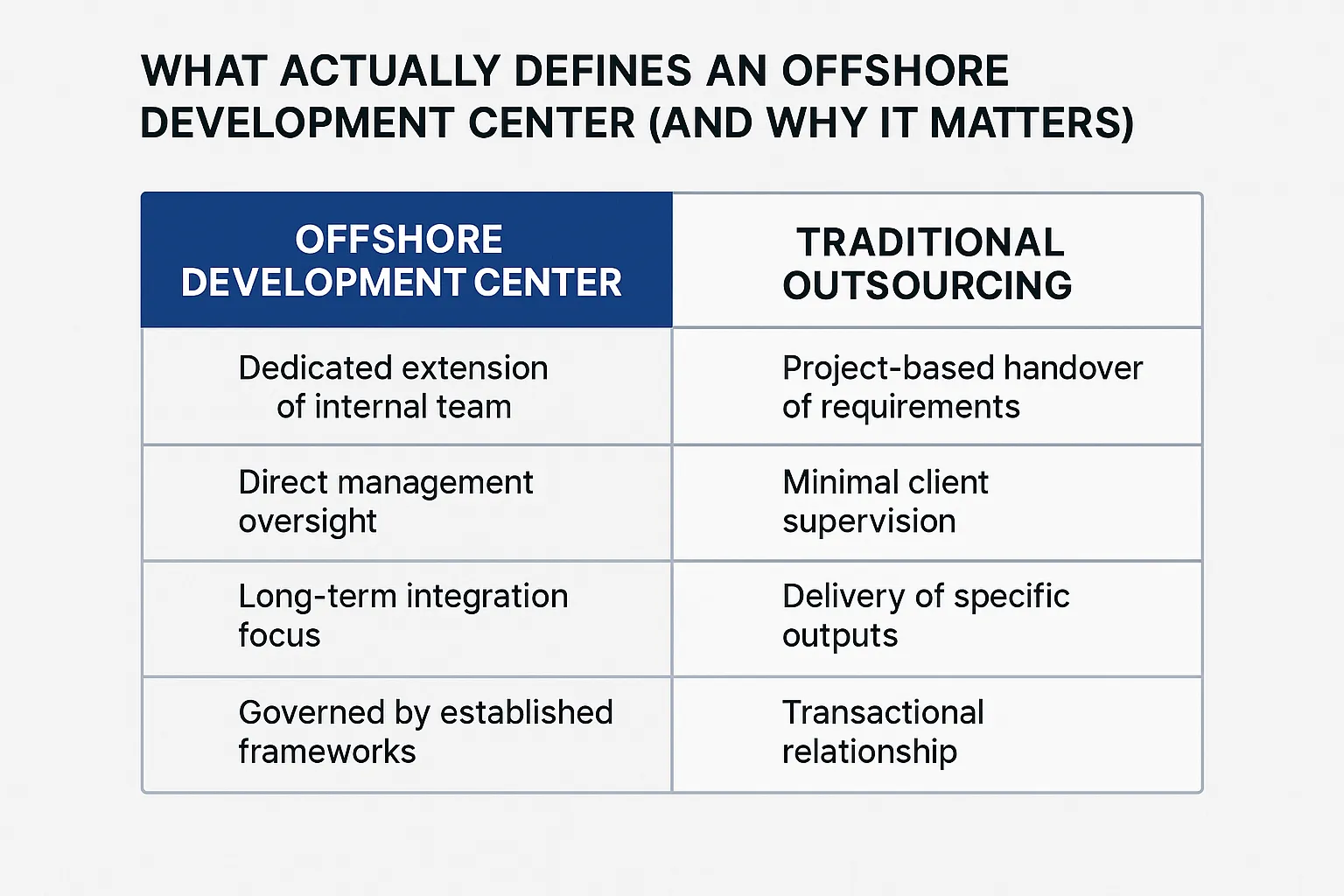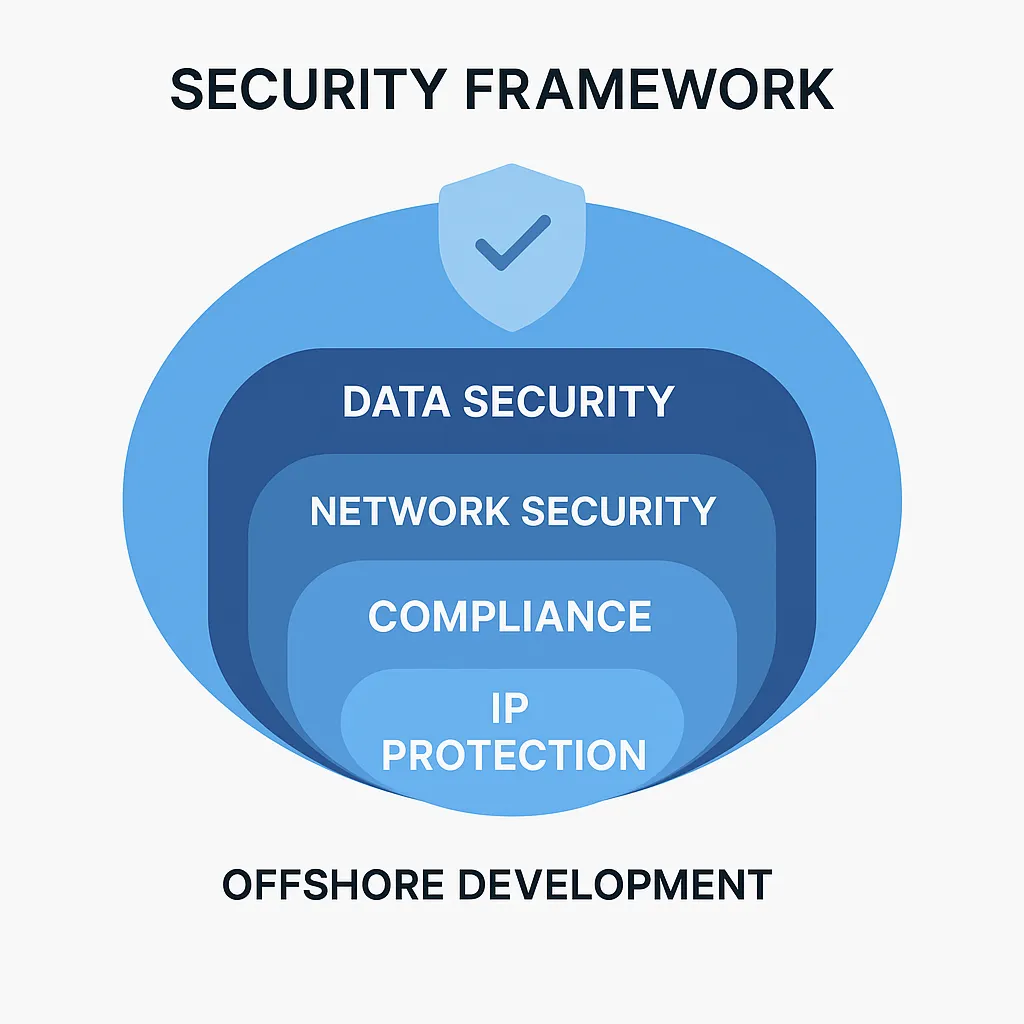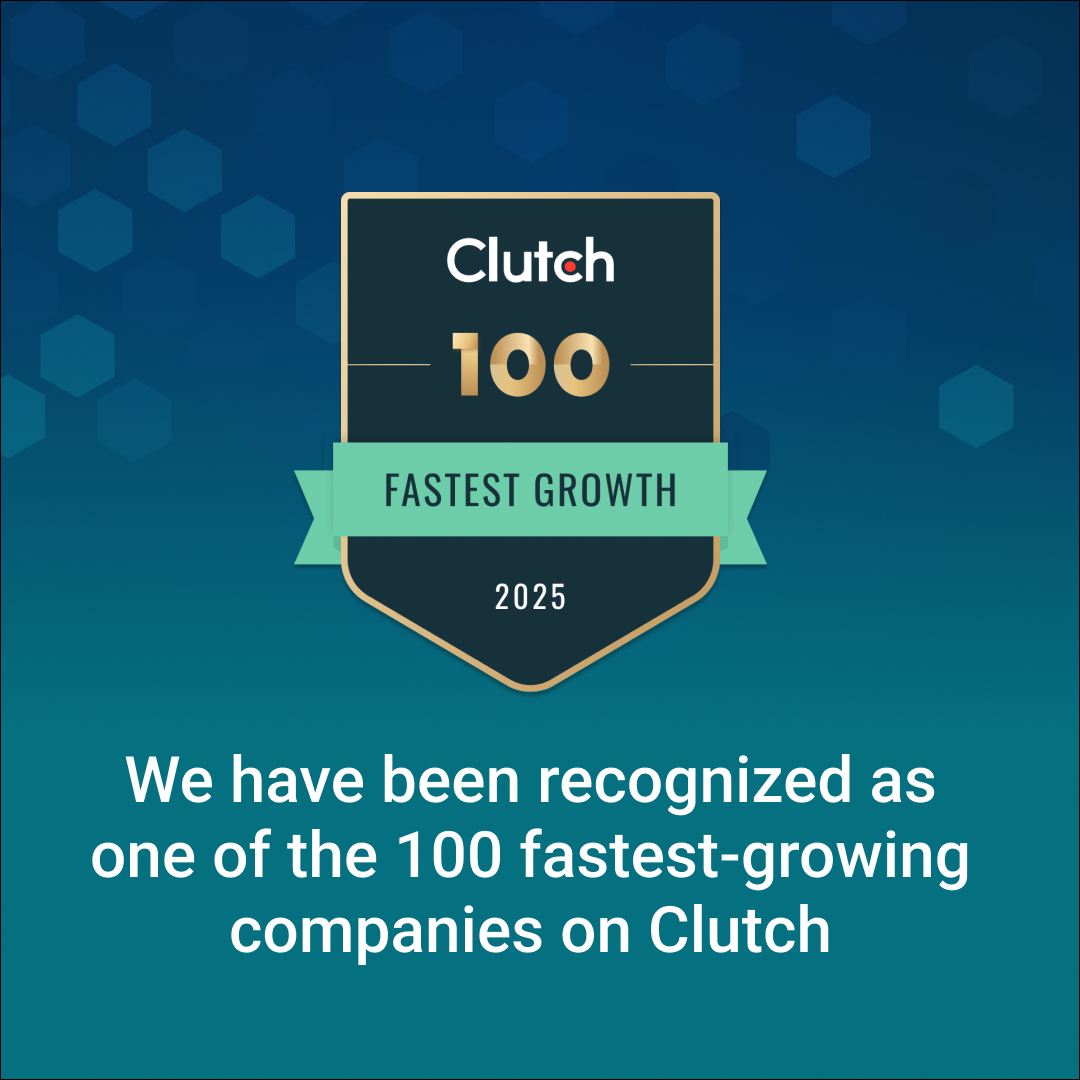The majority of Fortune 500 companies leverage some form of offshore or outsourced development, yet most CIOs still struggle with the go/no-go decision.
The reason?
Standard vendor pitches focus on cost savings while glossing over real operational risks that can derail entire digital strategies.
I’ve analyzed hundreds of offshore implementations (both successful and catastrophic). The companies that thrive with offshore development understand something their struggling peers miss: it’s not about finding the cheapest developers. It’s about building a strategic capability that amplifies your internal team while maintaining quality and security standards.
This analysis will walk you through the actual numbers behind offshore ROI, the specific risks that catch most CIOs off guard, and a practical framework for making this decision with your eyes wide open. The global offshore software development market is projected to reach $151.9 billion in 2025, with expectations to climb to $389.7 billion by 2033 at a 12.5% CAGR – but only organizations that properly assess both sides of the equation capture the real benefits.
TL;DR: The Real Numbers Behind Offshore Success
Offshore development centers deliver 30-60% cost savings and access to global talent pools, but success depends on robust security protocols, structured communication frameworks, and selecting partners with proper certifications like ISO 27001 and SOC 2 Type II compliance.
What Actually Defines an Offshore Development Center (And Why It Matters)
An offshore development center operates as a dedicated extension of your internal development team, located in a different country with direct management oversight and long-term integration goals. This differs fundamentally from project-based outsourcing where you hand off requirements and wait for deliverables.
Modern ODCs function as hybrid models that combine cost efficiency with quality control through established governance frameworks. Digital transformation initiatives consistently rank global team integration as a strategic priority, confirming that successful offshore operations require more than basic vendor relationships.
The strategic context for CIOs has shifted dramatically. Your offshore team should feel like colleagues working from another office, not external contractors you occasionally coordinate with. This integration mindset separates successful ODC implementations from expensive failures.

Fig.1 ODC vs. traditional outsourcing differences
The Real Cost Savings (Beyond the Marketing Headlines)
Offshore development typically reduces costs by 30-60% compared to domestic hiring, with additional savings from reduced infrastructure costs, lower employee benefits expenses, and optimized operational overhead. But the real numbers tell a more complete story.
Companies report significant annual savings when replacing domestic developers with offshore teams. However, these calculations often overlook management overhead, communication costs, and productivity adjustments during the integration period.
Here’s what actually drives the savings:
- Labor cost arbitrage – Hourly rates in key offshore markets
- Infrastructure efficiency – Shared facilities and equipment costs
- 24/7 development cycles – Time zone advantages for continuous delivery
- Access to specialized talent – Skills often unavailable domestically
India produces over 1.5 million STEM graduates annually, while Vietnam contributes approximately 94,000 STEM graduates yearly. Ukraine and Poland add another 210,000 combined, creating talent pools with specialized expertise often unavailable domestically.
Time zone advantages can accelerate product delivery significantly when properly managed. Organizations with offshore capacity maintain higher scalability rates compared to in-house-only models, allowing rapid team scaling without the 3-6 month hiring cycles typical in domestic markets.

Fig.2. Total cost of ownership for domestic vs. offshore teams over 24 months
Security Risks That Keep CIOs Awake at Night
Data security consistently ranks as the primary concern among CIOs considering offshore development partnerships, and for good reason. Cross-border data transfer regulations like GDPR create compliance complexities requiring specialized legal frameworks that most IT teams aren’t equipped to handle.
The biggest security vulnerabilities include:
- Intellectual property protection gaps – Jurisdictional differences in IP law enforcement
- Data transfer compliance – GDPR, CCPA, and industry-specific regulations
- Remote access vulnerabilities – Standard VPN connections aren’t enterprise-grade
- Communication-related security gaps – Misunderstood security protocols
- Regulatory compliance shifts – What’s compliant today might violate new regulations next quarter
A US healthcare company faced a security breach in 2024 due to lax vendor-side controls, losing $1.2M in regulatory penalties – a stark reminder that security failures carry real financial consequences.
Communication gaps amplify security risks significantly. Requirement misinterpretation rates ranging from 25-35% due to cultural and communication differences mean security protocols might not be implemented as intended, creating vulnerabilities that only surface during security audits or breaches.
The regulatory landscape keeps shifting. Your offshore partner needs dedicated compliance expertise, not just technical capabilities.
How to Actually Minimize Offshore Development Risks
Most enterprises now require ISO 27001 or SOC 2 compliance for new ODC vendors as baseline requirements, not nice-to-have features. Your security strategy should start with certified partners and build additional protections from there.
Essential risk mitigation strategies:
- Zero-trust network architectures with dedicated VPN connections
- Continuous security audits and governance frameworks
- Daily communication protocols with minimum overlapping work hours
- Enhanced QA processes designed for remote oversight
- Contractual safeguards beyond standard NDAs
Successful ODCs implement daily stand-ups and maintain overlapping work hours between onshore and offshore teams. This isn’t optional – it’s the foundation for preventing misunderstandings that lead to security gaps and quality issues.
Quality control demands more rigorous processes than domestic development. Remote QA processes require additional oversight compared to on-site models, with code review cycles often extending due to time zone and communication delays.
High-functioning ODCs achieve significantly higher code coverage in automated testing compared to global medians, proving that structured oversight processes work when properly implemented.

Fig.3 Layers of protection for offshore development
Ready to evaluate whether an Offshore Development Center is the right strategic move for your engineering organisation?
Explore how CIOs assess ODC suitability through cost-benefit analysis, delivery governance, team scalability, and long-term operational resilience.
Compare ODCs with fixed-price and time-and-material models to see which structure delivers the best balance of risk, control, and ROI.
Explore the 2026 Offshore Development Center Decision GuideChoosing the Right Partner (The Non-Negotiable Criteria)
Language and culture fit consistently rank among top CIO selection criteria, but technical capabilities remain the foundation. You need partners with proven expertise in your specific technology stack and industry requirements.
Essential evaluation criteria:
- Security certifications – ISO 27001 and SOC 2 Type II as minimums
- AI development capabilities – The gap between AI-certified developers varies dramatically across vendors
- Infrastructure assessment – Version control, CI/CD pipelines, monitoring capabilities
- Communication skills – Direct technical interviews, not vendor presentations
- Trial engagement results – 4-week pilots predict long-term success better than any vendor deck
The AI revolution has created new evaluation criteria. AI-assisted development is becoming table stakes, not a competitive advantage. Only a small percentage of offshore vendors hold both ISO 27001 and SOC 2 Type II certifications, making these credentials significant differentiators.
Trial engagements predict long-term success better than any vendor presentation. Direct communication assessment through technical interviews and project discussions reveals real-world effectiveness that vendor claims can’t capture.
Your 90-Day ODC Implementation Roadmap
Most enterprises struggle to set up secure environments in the first 30 days, causing rollout delays averaging 17 days. Your implementation timeline should prioritize security infrastructure before scaling team operations.
Phase 1 (Days 1-30): Foundation Building
- Complete vendor selection and contract finalization
- Establish security infrastructure and access controls
- Implement communication tools and protocols
- Define quality assurance frameworks
Phase 2 (Days 31-60): Integration Testing
- Launch pilot projects at 20-30% of normal workload
- Test collaboration workflows and communication rhythms
- Optimize daily stand-ups and review processes
- Identify and address integration challenges
Phase 3 (Days 61-90): Scale and Optimize
- Scale team size based on pilot performance
- Implement lessons learned from integration phase
- Establish long-term communication schedules
- Set up ongoing performance monitoring
Pilot projects representing a fraction of normal workload are the most common entry strategy, allowing you to test collaboration workflows without risking critical deliverables. ODCs that optimize communication schedules post-pilot report significantly higher satisfaction in year one.
How to Measure Real ODC Success (Beyond Cost Savings)
Companies achieve targeted cost reductions when KPIs like story points, bug rates, and code review times are monitored quarterly. But cost metrics tell only part of the story – quality and delivery velocity matter just as much.
Key performance indicators to track:
- Development velocity – Story points completed per sprint
- Code quality metrics – Bug rates, review turnaround times, technical debt
- Stakeholder satisfaction – Monthly surveys on communication and delivery
- Team retention rates – Both offshore and onshore employee retention
- Security compliance – Audit results and incident reports
Track development velocity using story points completed per sprint, comparing offshore and onshore team productivity. Monitor code quality including bug rates, code review turnaround times, and technical debt accumulation. Mature ODC engagements typically achieve high code coverage and significant drops in post-release bugs.
Stakeholder satisfaction provides crucial qualitative insights that quantitative metrics miss. Monthly stakeholder satisfaction surveys should evaluate communication effectiveness and delivery quality, creating necessary feedback loops for continuous improvement.
When ODCs Make Strategic Sense (And When They Don’t)
Companies with clear development processes and strong technical leadership maximize offshore partnership benefits. If your internal team struggles with basic project management or quality control, offshore development will amplify these problems rather than solve them.
ODCs work best for organizations with:
- Established development processes and quality standards
- Strong internal technical leadership
- Clear communication protocols
- Talent shortages in specialized technologies
- Rapid scaling or cost optimization needs
Avoid ODCs if your company has:
- Unclear domestic development structures
- Highly sensitive data with regulatory restrictions
- Requirements for frequent in-person collaboration
- Weak internal project management capabilities
Organizations facing talent shortages in specialized technologies should prioritize offshore access to global expertise. The AI revolution has created particularly acute skill gaps – finding AI-certified developers domestically is both expensive and time-consuming.
Businesses requiring rapid scaling or cost optimization will find offshore development centers strategically valuable. However, companies without established development processes should focus on internal improvements before considering offshore expansion.
Why SmartDev Addresses These Key CIO Concerns
SmartDev’s ISO 27001 and SOC 2 Type II certifications address the primary security concerns that keep CIOs awake at night. These aren’t marketing badges – they represent audited, verified security frameworks that meet enterprise compliance requirements.
SmartDev’s AI-certified developer workforce provides access to cutting-edge development capabilities often unavailable in domestic markets. While the global offshore industry struggles with AI literacy gaps, SmartDev’s entire team works with AI-assisted development tools daily.
Swiss quality standards combined with Vietnamese cost efficiency deliver optimal value propositions for enterprise clients. This combination of proven security frameworks, AI expertise, and hybrid quality models makes SmartDev uniquely positioned to address the strategic and operational challenges that typically derail offshore development initiatives.
Ready to explore how offshore development could transform your technical capabilities? Download our complete Offshore Software Development Guide or explore our talent solutions to see how SmartDev addresses the specific risks and opportunities outlined in this analysis.








